Megan Dunn – 24 August, 2012
Laird's ‘library' courts both our curiosity and our aspirations. The Penguin classics in the mix are unmistakeable, their orange covers now a signifier not only of a great read, but also of a great reader. To slip one under your arm and walk down the street is to become an arbiter of style: put a Penguin in your pocket and you own a little piece of literature with a capital L.
Reading Room is an exhibition with plenty of character. Look through the window of Objectspace today and you will see the rubble of a bookcase, lined with books, face out and spine on. A low lying table is scattered with more titles, some splayed open, others closed. A nearby chair and pouffe invite you - the reader - to take a seat, put your feet up and linger awhile. This scene is dear to the heart of many a bibliophile. It’s almost a cliché. However, the books are made of clay and the furniture is built from bricks. It’s pretty hard reading.
This window work is a collaboration between artist Tessa Laird and senior ceramicist Peter Lange. She made the books, he did the bricks. Against all odds, Lange’s art-deco furniture actually looks homely and approachable. The arched armrests of his chair, echo the curved spines of bridges; I hear water bubbling along a river and rushing under the village bridge, then flowing out past the dappled green fields beyond. The landscape Lange’s furniture conjures in my mind is a British idyll, or maybe it’s actually middle-earth? I can equally imagine his furniture inside a hobbit hole, Bilbo Baggins sitting on the brick pouffe, while Ganddalf the Grey, leans back on the chair and smokes his pipe. But already I’m talking about books again. Lange’s furniture is the tableau for Tessa Laird’s clay bibliography.
Reading Room is the perfect distillation of her practice; she’s an artist perhaps still more widely known for her writing. One of her previous texts is entitled: Shards of the Jealous Potter. In this exhibition Laird gets to have her cake and eat it too. We can’t flick through the pages of the books and the words on offer are not her own.
The clay books represent three years of Laird’s reading, much of which was undertaken during her doctorate at Elam. Covers on colour abound. I like the way her research has been restored to the surface, rather than depth. Laird offers us the world of appearances. Each book is nothing more (or less) than its cover. At the moment art schools seem so preoccupied with theory and research, it’s no wonder the idea often looms larger than the object itself. Artists are always talking about their practice and their research. It can become quite po-faced, as though art is a terribly seriously enterprise that should only be taken seriously. Yet the successful art object can be just as superficial and seductive as a new lover.
Laird’s ‘library’ courts both our curiosity and our aspirations, including our arrogance. Many of her clay books have sold. The Penguin classics in the mix are unmistakeable, their orange covers now a signifier not only of a great read, but also of a great reader. To slip one under your arm and walk down the street is to become an arbiter of style: put a Penguin in your pocket and you own a little piece of literature with a capital L. Lying on the bricks, in wibbly wobbly stripes of orange and brown is Penguin by Design: A Cover Story 1935-2005. A savvy choice for the jealous potter and yes, it has sold. Laird encourages us to openly judge her books by their covers, knowing that books aren’t mere strangers, they are portraits and portals into our own lives too.
I wanted to buy her version of The White Album by Joan Didion (also sold). I still remember reading the first page in a Waterstones store in Camden Town, then dipping into my pocket and spending my last 20 quid on it. ‘We tell ourselves stories in order to live,’ Didion writes. ‘The princess is caged in the consulate, the man with the candy will lead the children into the sea.’ It’s an outstanding beginning to an outstanding book. And it offers one of the best summaries of why stories matter, of what stories do. What does art do? I wish I could tell you. I wish I knew.
Reading Room is packed with metaphors and visual puns: stone furniture, books that you can break like bread. But the exhibition title is also a nod to how we learn about art and discuss it, ever poised and ready to offer up another ‘reading,’ no matter how resistant the art might be to our analysis. In life, the limits of our own thought and knowledge are pressing, at worst oppressive. Is the book itself just another brick in the wall?
In the age of the smartphone and the I-pad, Laird reminds us of the clay tablet, the humble homespun origins of the written word. Books like clay birds are a target. The paperback is threatened with extinction yet again.
I was a bookseller for a decade. I worked for Borders and I’ve seen the collapse of that chain and the swift impact of the internet, e-books and the recession. I’ve had countless discussions with people about the demise of the bookstore and how wonderful The Book Depository is (now owned by Amazon). I’ve also heard the argument from the defence: the paperback is an irreplaceable object, and it smells great too! Now that the book seems threatened, like a paper bird about to fly into the sun, we’re all busy trying to preserve the scent of it. There are several perfumes on the market, including Karl Lagerfield’s ‘For Booklovers.’
Books are a common fetish (remember Parsons and the numerous artists who worked there…) so it seems apt that Laird’s library is personalised. Even quaint and quirky. She doesn’t shy away from the shonky - maybe she can’t - but in this context the naivety of her hand-drawn linework is charming, as are her blurry covers.
Bookselling and publishing - like pottery - has traditionally been a cottage industry. The future of the market is indistinct. These books are fragile; we covet them but we must also take care of them. In a sci-fi classic by Ray Bradbury, the firemen of the future burn books to suppress thought. Fahrenhiet 451 is the temperature at which they burn. I love Laird’s reversal; from the fire, not ash but clay. The book isn’t dead, it’s just in the kiln. Long live ceramics.
Megan Dunn
Recent Comments
John Hurrell
I agree with your scorn of that Unity Books shelf label, Ralph. I feel the same way. And I guess ...
Ralph Paine
You're being as cringey and ridiculous as the proprietors of Unity Books in Auckland, where rather than label what is ...
Megan Dunn
Well, I think it doesn't preclude those interpretations, but I don't think it is hemmed in by them either. Books ...
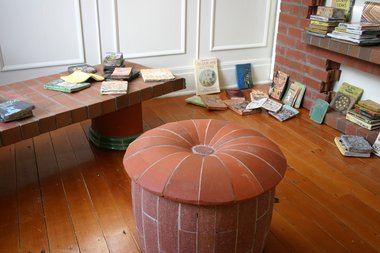





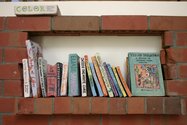
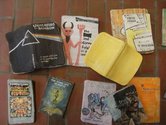
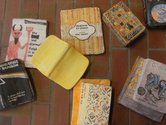
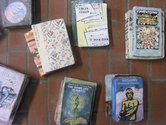
 Advertising in this column
Advertising in this column Two Rooms presents a program of residencies and projects
Two Rooms presents a program of residencies and projects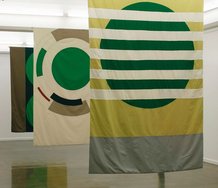
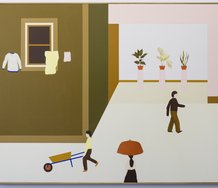
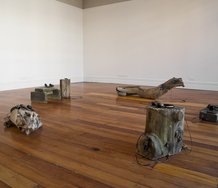
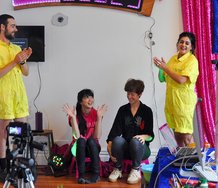
This Discussion has 4 comments.
Comment
John Hurrell, 7:45 a.m. 24 August, 2012 #
I suppose the question a show like this raises is 'What is an intellectual?' Laird works in a brusherly manner related to say Erica van Zon and her posters. (Reminds me of Malcolm Morley in the 70s). There is a 'folksy' aesthetic that leans on gestural mark making.
But with books as subject matter one wonders what is the message here? Is the artist making a declaration about themselves? What are they trying to assert as ostentatious 'reader'? Are they (for example) making claims that they are 'brainy'?
It seems to be about an aspiration to be part of a certain sort of 'learned' academic community and broadcasting that.
Ralph Paine, 2:20 p.m. 27 August, 2012 #
You're being as cringey and ridiculous as the proprietors of Unity Books in Auckland, where rather than label what is clearly the philosophy section "Philosophy", they instead label it "Brainy Stuff".
John Hurrell, 2:38 p.m. 27 August, 2012 #
I agree with your scorn of that Unity Books shelf label, Ralph. I feel the same way. And I guess there is the argument that if something exists in the world, it is potentially fitting subject-matter for art. However my comment is aimed at the ostentatious social signal of the book cover, and not the argued content or investigative research found within the publications themselves.
Megan Dunn, 9:07 a.m. 24 August, 2012 #
Well, I think it doesn't preclude those interpretations, but I don't think it is hemmed in by them either. Books are a portrait both of who we are and who we want to be. And an addiction, I am always buying new books - that I don't read - convinced I somehow need them...
Whether your book case is publically on display or not, what you read is a window into your class, interests and education. Think of all the accusations about the Booker Prize being middle class and snobbish.
Laird's wobbly lines, her sketchy covers, suggest well worn, well loved titles, but also a kind of incompetence. The books will always overcome us...there are too many...we can never know enough...
Participate
Register to Participate.
Sign in
Sign in to an existing account.